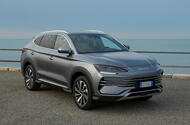BYD Seal U DM-i, a plug-in hybrid, is the firm’s “global sales champion”
BYD president says plug-in hybrids have a “very important role” to play in the brand’s European growth
BYD will launch three new plug-in hybrids (PHEVs) alongside three electric cars in Europe next year as it pushes for a more comprehensive product portfolio to boost its market share in the face of ailing EV demand and swingeing import tariffs.
The Chinese company is the world’s second best-selling electric car manufacturer, only narrowly being outstripped by Tesla in the second quarter of this year, and is quickly growing its market share in Europe following its launch in the market in 2022.
Its European line-up is predominantly pure-electric, but it has recently launched a plug-in hybrid version of the Seal U crossover and BYD president Stella Li has told Autocar that PHEVs have a “very important role” to play in sustaining the company’s upward trajectory.
“BYD is different. Tesla only has EVs but we have PHEVs,” she said, referring to them as a “game-changer” offering.
Li says PHEVs like the Seal U DM-i are gaining renewed importance as a bridge to full electrification for wary would-be electric car buyers. She said: “A lot of people want to try electric cars, but currently they have range anxiety and hesitate, but this car gives them the solution.”
According to Li, this is particularly prevalent in China, where the popularity of PHEVs and range-extender vehicles (REVs) currently outstrips pure EV. She said: “China is the leading country for the new-energy [electrified] car, and the yearly penetration of EVs is 40%, but more than 50% is PHEV – and our data shows that mainstream people use PHEV as the first experience for EVs.
“But after several years, they replace that with a new car, and 60-70% were very open to buying an EV.”
However, this phenomenon is not unique to China, she emphasised, highlighting that 60-70% of BYD’s sales in Spain are for the Seal U DM-i PHEV, which is the company’s “global sales champion” – though 85% of units are sold in its home country.
![]()
Li cited the flexibility and reduced running costs of a PHEV powertrain as the principal selling points. “Once you introduce PHEVs and educate people and offer them at a competitive price, people realise the saving. Then the number of NEVs [new-energy vehicles] will see very solid growth,” she said.
Li stopped short of confirming which PHEVs BYD will bring to Europe next year, but it sells DMI versions of the Seal 06 and Seal 07 saloons in China, as well as the Song-L crossover.
The brand plans to launch its Fangchengbao range-extender 4x4s in mainland Europe and the UK in the near future, but Autocar understands these are separate from BYD’s PHEV push.
The company will also bring three new EVs to the European market, possibly including the Ocean-M hatchback and Sea Lion crossover.
Diversifying its powertrain offering in Europe will help BYD to mitigate the impact of the substantial 17.4% import tariffs that have been imposed on its Chinese-built pure-electric cars by the EU Commission, though the company is also working to quickly establish European factories so it can avoid these entirely.
The company will begin building cars at its new factory in Hungary by the end of 2025 and a separate new facility in Turkey will come online shortly after, which would make BYD the first Chinese car brand to open its own European factory.
“BYD is a global leader and now we are turning ourselves into a local company,” Li said. “Localisation is one of our key targets. In the next two years, BYD will become a European company. We will produce locally. We will do R&D locally. BYD will become really a European brand.”
She said BYD has not yet decided which cars it will build on the site but suggested all current and future European-market models would be considered. “The most popular cars we will produce locally here,” Li said.
Source: Autocar
